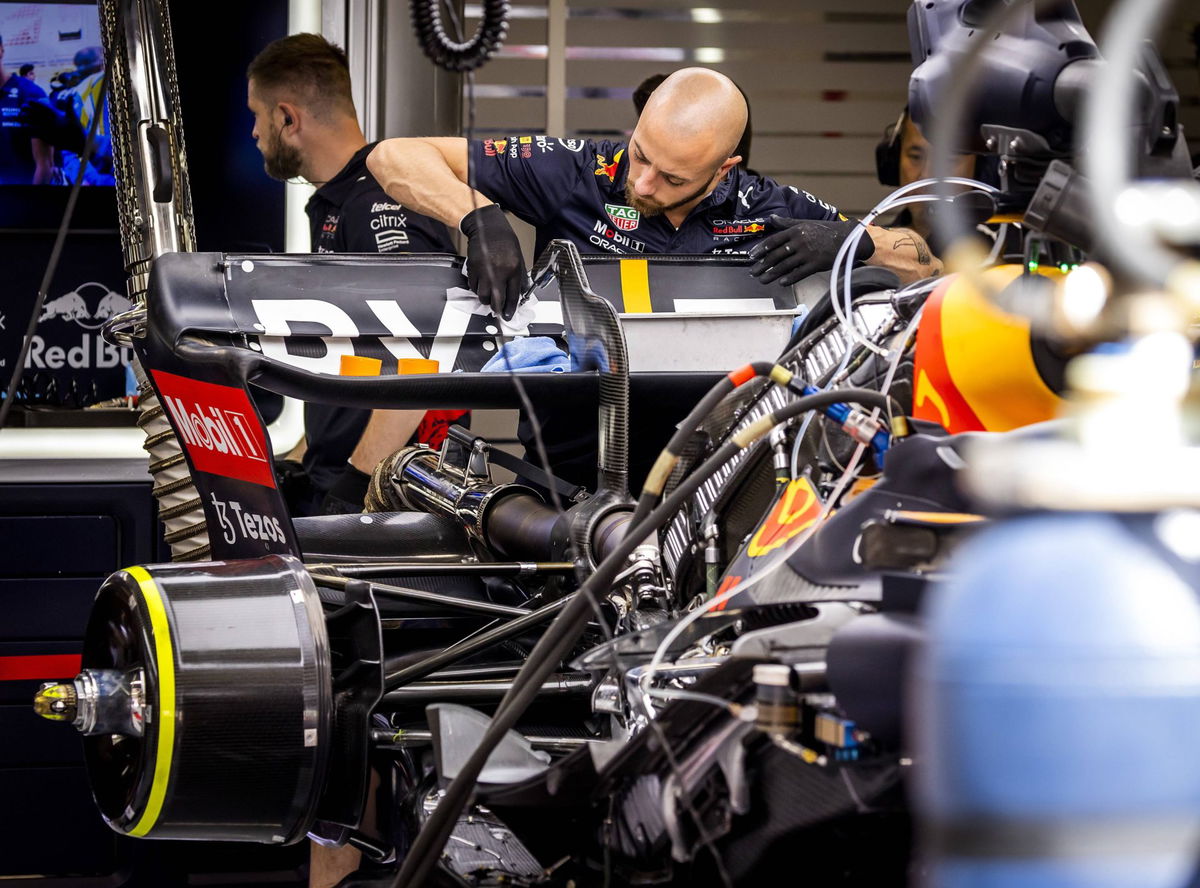
Imago
BARCELONA – Red Bull Racing engineers are working on the rear wing of Max Verstappen s car whose DRS, the movable section, failed during qualifying yesterday, ahead of the F1 Grand Prix of Spain at Circuit de Barcelona-Catalunya on May 22, 2022 in Barcelona, Spain. REMKO DE WAAL F1 Grand Prix of Spain, RACE 2022 xVIxANPxSportx/xxANPxIVx *** BARCELONA Red Bull Racing engineers are working on the rear wing of Max Verstappen s car whose DRS, the movable section, failed during qualifying yesterday, ahead of the F1 Grand Prix of Spain at Circuit de Barcelona Catalunya on May 22, 2022 in Barcelona, Spain REMKO DE WAAL F1 Grand Prix of Spain, RACE 2022 xVIxANPxSportx xxANPxIVx 449017285 originalFilename: 449017285.jpg

Imago
BARCELONA – Red Bull Racing engineers are working on the rear wing of Max Verstappen s car whose DRS, the movable section, failed during qualifying yesterday, ahead of the F1 Grand Prix of Spain at Circuit de Barcelona-Catalunya on May 22, 2022 in Barcelona, Spain. REMKO DE WAAL F1 Grand Prix of Spain, RACE 2022 xVIxANPxSportx/xxANPxIVx *** BARCELONA Red Bull Racing engineers are working on the rear wing of Max Verstappen s car whose DRS, the movable section, failed during qualifying yesterday, ahead of the F1 Grand Prix of Spain at Circuit de Barcelona Catalunya on May 22, 2022 in Barcelona, Spain REMKO DE WAAL F1 Grand Prix of Spain, RACE 2022 xVIxANPxSportx xxANPxIVx 449017285 originalFilename: 449017285.jpg
“Oh, Jesus!” exclaimed VCARB’s baffled Yuki Tsunoda after learning about his 60-place grid penalty for the 2024 Belgian GP. In comparison, Red Bull’s Max Verstappen was slapped with a 10-place grid penalty for similar engine reasons during the same weekend. While the Dutchman’s penalty is understandable, how on earth did the FIA decide to set Tsunoda back by 60 places in an F1 race that only has 20 drivers? Well, now that you’ve landed here, we’ve got you covered.
Watch What’s Trending Now!
Such big grid penalties usually stem from engine changes during an ongoing season. F1’s governing body, the FIA, sets a limit on the maximum number of engine components that can be changed legally. If any team breaches the limit, they incur grid penalties. Let’s start off by understanding what these penalties are.
ADVERTISEMENT
F1 Engine component allocations and the enforcing of penalties
The Current F1 power units (or engines) comprise 7 main elements: Internal combustion engine (ICE), turbocharger, motor generator nit-heat (MGU-H), motor generator unit-kinetic (MGU-K), energy store, control electronics, and exhaust. For 2023, 2024, and 2025, the allocation of these elements for one F1 season is as follows:
- For the first four elements, namely, ICE, turbocharger, MGU-H, and MGU-K, a driver can only use 4 of each.
- For the energy store and control electronics, a driver can only use 2 of each.
- For the exhaust, the FIA gives teams more breathing space, allowing 8 to be used for a driver.
If any driver’s car crosses the limits of any individual component, grid penalties are imposed at the event for which the additional components are utilized. According to F1, “The first time the allocation of any of the seven elements is exceeded, a 10-place grid penalty will be applied, with the second time this occurs (and so on) resulting in a five-place grid drop – all penalties at the same event applying in a cumulative manner.” Furthermore, if a driver incurs a penalty exceeding 15 grid places, they’ll start the race at the back.
ADVERTISEMENT

Reuters
Formula One F1 – Bahrain Grand Prix – Bahrain International Circuit, Sakhir, Bahrain – February 28, 2024 RB’s Yuki Tsunoda ahead of the Bahrain Grand Prix REUTERS/Hamad I Mohammed
For a real-life example, let’s revisit Yuki Tsuonda’s 2024 Belgian GP case. VCARB exceeded the allocation for 6 engine components out of 7. Except for the exhaust, all other components on the Japanese driver’s VCARB 01 breached the limit, thus, giving him a 10-place penalty for each of the 6 components, which amounted to the 60-place penalty. Comparatively, Red Bull only changed the ICE (5th of the season) on Max Verstappen‘s RB20, earning him a 10-place grid penalty.
ADVERTISEMENT
Now that you know the repercussions of the change, let’s backtrack a bit to see why these changes are needed in the first place.
Top Stories
Language Barrier Didn’t Hold Back Lando Norris to “Hook Up” With OnlyFans Model: “We Talked by Mime”

Zak Brown & McLaren Possibly in Deep Trouble as Mercedes Cuts Engine Supply for F1 2026

Who Are Lando Norris’s Parents? Meet Adam Norris and Cisca Wauman

Adrian Newey’s Motorsport Masterpiece: RB17 vs Aston Martin Valkyrie, Which One Is Better?

3 Years After His Death, Niki Lauda’s Wife Brutally Disrespects Him to Initiate $32,000,000 Battle Against Own Children

Why do F1 teams change engine components midway through a season?
F1’s current regulations (2022 to 2025) dictate that teams must use a four-stroke 1.6-litre V6 engine, which has the aforementioned parts. The rules in this ground-effect era allow cars to touch a maximum of 15000 RPM. RPM refers to the revolutions per minute taken by an engine’s crankshaft. For simplicity’s sake, let us steer clear of the crankshaft for now. In comparison, an average road car operates somewhere around 1500-2500 RPM.
ADVERTISEMENT
Depending on the nature of F1 tracks and driver style, the wear and tear of the engine component changes. Because it is the pinnacle of motorsport. Maximum performance is what drivers demand and so do the fans. The more the cars race, the higher the chance of the need for a component change. For sustainability reasons, the FIA has set a certain allocation. Otherwise, the teams would go ham changing parts more than necessary.
Before the current regulations were imposed in 2022, the FIA introduced an ‘engine freeze’. The manufacturers were asked to submit the final design of their F1 engines before the 2022 season started. So, at no point before the newer regulations are implemented in 2026, can the teams develop their engines. The change of parts that ensue during a season is mainly from the wear and tear of the components. Architectural changes to the engine are only permitted if reliability issues are present.

Reuters
Formula One F1 – Canadian Grand Prix – Circuit Gilles Villeneuve, Montreal, Canada – June 9, 2024 Mercedes’ Lewis Hamilton in action during the race REUTERS/Mathieu Belanger
Mercedes, Ferrari, Honda, and Renault are the only engine manufacturers in F1 today. The other teams on the grid are ‘customer’ teams, sourcing their engines from one of these four teams. The Mercedes engine is the most used: by McLaren, Williams, Aston Martin, and themselves. Honda supplies engines to Red Bull and VCARB. Ferrari, excluding themselves, serves two customers in Sauber and Haas. Renault only supplies to Alpine.
ADVERTISEMENT
However, Renault will be shutting their F1 engine project, come 2026. Contrarily, Red Bull (supported by Ford) and to-be-entrants Audi will step up, making their own power units. In 2026, a new wave of regulations will be implemented, also affecting the F1 engines. The allocations will change with the MGU-H being shown its way out from modern F1 engines. The MGU-K allocation could increase, considering that it’ll be tasked with tripling the amount of electrical power produced by the current components.
ADVERTISEMENT
ADVERTISEMENT
ADVERTISEMENT

